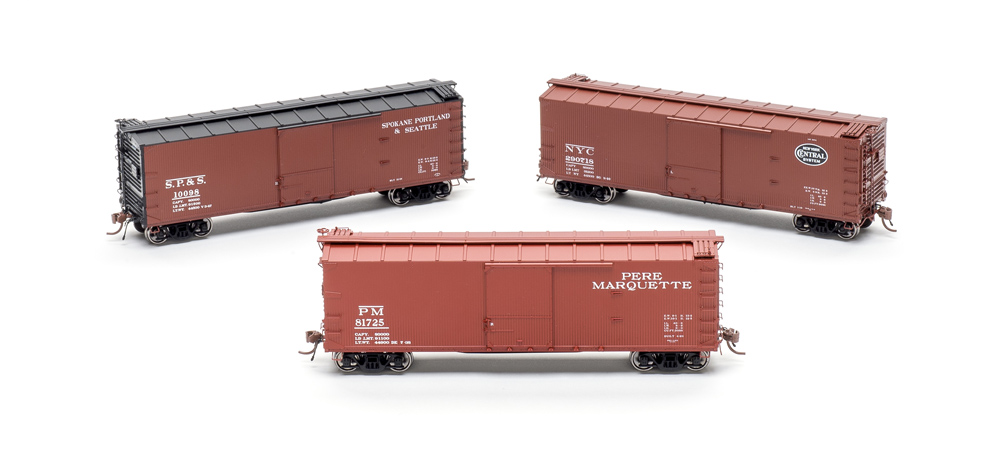
With about 25,000 built, the United States Railroad Administration 40-foot double-sheathed boxcar is one that deserves a place on any transition-era or earlier model railroad. Rapido’s model will help you fill your roster with highly detailed examples fitted with the correct style of brake for the paint schemes offered.
War babies
The double-sheathed boxcar was rated to carry 40 tons. The double-sheathed design had a wooden truss frame covered inside with horizontal and outside with vertical wood sheathing.
A deep fish-belly-shaped center sill was a characteristic of the double-sheathed car, and they were often rebuilt in the 1940s with steel sides because of the double-sided wood cars’ tendency to rot. A variety of builders built the cars, including the well-known American Car & Foundry and the lesser-known Keith Car & Mfg. Co. The cars, rostered by dozens of railroads, were often built with KC style brakes, notable for a combined brake cylinder and air tank. Many were updated with more modern AB style brakes.
Detailed models
Our three samples were lettered for the New York Central (NYC); Pere Marquette (PM); and Spokane, Portland & Seattle (SP&S). All paint was smoothly applied with sharp separations between the oxide red sides and black roof and ends of the SP&S car. All lettering was sharp and legible.
The models are well detailed. All stirrup steps and grab irons are formed and painted wire. The tack boards on both ends, and the brake platforms, retainer pipes and valves, brake staffs and brake wheels on the B end, are separate parts.
Flipping the model over I found the NYC and PM models were equipped with KC-style brake equipment, while the SP&S car had AB style brakes. The cars were built with KC brakes, which were upgraded to extend the useful lives of the cars. Rapido includes components from the brake type not installed if the modeler wants to make the change. To accommodate this, the mounting holes are molded into the floor whether the parts are assembled there or not.
The signature fish-belly center sill, four large center crossbearers, and truck bolsters are molded separately from the floor, as are most of the brake piping and rigging. Smaller intermediate crossties and floor sheathing are molded on the floor bottom. Screw-mounted Andrews U-section trucks carry turned metal wheelsets on insulated metal axles. I liked that the brake shoes line up with the wheel treads. The wheels were all in gauge. Rapido’s Macdonald-Cartier metal knuckle couplers were mounted in molded-in draft-gear boxes with screwed on covers. The couplers matched a Kadee coupler height gauge.
On the rails
The cars easily negotiated Atlas no. 4 and no. 6 turnouts. I did notice the cars were a bit wobbly. Usually, tightening the truck screws will take care of this, but in this case, the center bolster boss stands higher than the thickness of the truck bolster. A few swipes with a small mill file on one of the body bolster bosses allowed me to tighten one of the trucks to the frame. Backing off a quarter turn or so allows the truck to rotate without rocking. I left the other truck to rock. This lets the cars negotiate any unevenness in my trackwork. The cars weigh 3.9 ounces, correct per National Model Railroad Association Recommended Practice 20.1.
Uncommon detail on a common car
Rapido has again produced a well-designed and detailed product. These cars roamed the North American rail network for more than 30 years in large numbers. If you’re a steam or transition-era modeler, your railroad could use a few of these boxcars.
Facts & Features
Price: $49.95
Manufacturer
Rapido Trains Inc.
500 Alden Road, Unit 21
Markham, Ontario L3R 5H5
Canada
rapidotrains.com
Era: 1920-mid-1950s
Road names: New York Central; Pere Marquette; Spokane, Portland & Seattle; Atchison, Topeka & Santa Fe; Boston & Maine; Chicago, Burlington & Quincy; Chicago, Rock Island & Pacific (Rock Island); Great Northern; Lackawanna; Minneapolis & St. Louis; Missouri Pacific; St. Louis-San Francisco (Frisco); Toronto, Hamilton & Buffalo (red or yellow); and Wabash
Features
Blackened turned-metal wheels, in gauge
KC or AB brakes as appropriate
Factory-installed Macdonald-Cartier couplers, at correct height
Full underbody with separate brake rods and piping
USRA Andrews trucks with in-line brake shoes
Weight: 3.9 ounces, correct per National Model Railroad Association Recommended Practice 20.1













